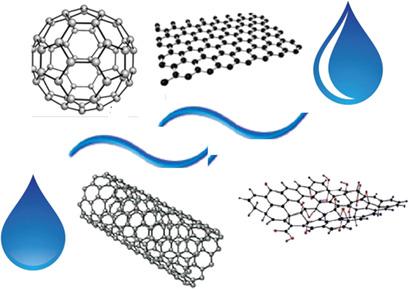当前位置:
X-MOL 学术
›
ChemBioEng Rev.
›
论文详情
Our official English website, www.x-mol.net, welcomes your
feedback! (Note: you will need to create a separate account there.)
Carbon Nanomaterials for Wastewater Treatment
ChemBioEng Reviews ( IF 6.2 ) Pub Date : 2021-06-19 , DOI: 10.1002/cben.202100003 Hanna S. Abbo 1, 2 , K. C. Gupta 3 , Nader G. Khaligh 4 , Salam J. J. Titinchi 1
ChemBioEng Reviews ( IF 6.2 ) Pub Date : 2021-06-19 , DOI: 10.1002/cben.202100003 Hanna S. Abbo 1, 2 , K. C. Gupta 3 , Nader G. Khaligh 4 , Salam J. J. Titinchi 1
Affiliation

|
The research progress made in recent years in removal of organic-inorganic pollutants from wastewater using various types of carbon materials as adsorbents such as carbon nanotubes, carbon nanofibers, graphenes, graphitic carbon nitride, fullerene, activated carbon spheres, and carbon quantum dots is reviewed. These carbon nanomaterials with hierarchical structures are efficient and economical adsorbents. The techniques of metal impregnation and doping help to control the porosity and surface area of nanomaterials. Electrostatic forces, π-π and π-e interactions, van der Waals weak forces, and oxygen-containing groups are considered responsible for the removal of pollutants from wastewater. The carbon nanomaterial-based photocatalysts are applied successfully in decomposition of persistent dyes under visible light. Fe3O4 magnetic material is employed as recyclable adsorbent after treatment of wastewater. Freundlich and Langmuir models are found more suitable to calculate the adsorption efficiency and adsorption kinetics of pollutants. Criteria and properties of carbon nanomaterials are discussed that might play a significant role in remediation of wastewater.
中文翻译:

用于废水处理的碳纳米材料
综述了近年来以碳纳米管、碳纳米纤维、石墨烯、石墨氮化碳、富勒烯、活性炭球、碳量子点等各类碳材料为吸附剂去除废水中有机-无机污染物的研究进展. 这些具有分级结构的碳纳米材料是高效且经济的吸附剂。金属浸渍和掺杂技术有助于控制纳米材料的孔隙率和表面积。静电力,π-π和π-e相互作用、范德华弱力和含氧基团被认为是从废水中去除污染物的原因。基于碳纳米材料的光催化剂成功应用于可见光下持久性染料的分解。Fe 3 O 4磁性材料用作废水处理后的可回收吸附剂。Freundlich 和 Langmuir 模型更适合计算污染物的吸附效率和吸附动力学。讨论了可能在废水修复中发挥重要作用的碳纳米材料的标准和特性。
更新日期:2021-06-19
中文翻译:

用于废水处理的碳纳米材料
综述了近年来以碳纳米管、碳纳米纤维、石墨烯、石墨氮化碳、富勒烯、活性炭球、碳量子点等各类碳材料为吸附剂去除废水中有机-无机污染物的研究进展. 这些具有分级结构的碳纳米材料是高效且经济的吸附剂。金属浸渍和掺杂技术有助于控制纳米材料的孔隙率和表面积。静电力,π-π和π-e相互作用、范德华弱力和含氧基团被认为是从废水中去除污染物的原因。基于碳纳米材料的光催化剂成功应用于可见光下持久性染料的分解。Fe 3 O 4磁性材料用作废水处理后的可回收吸附剂。Freundlich 和 Langmuir 模型更适合计算污染物的吸附效率和吸附动力学。讨论了可能在废水修复中发挥重要作用的碳纳米材料的标准和特性。











































 京公网安备 11010802027423号
京公网安备 11010802027423号